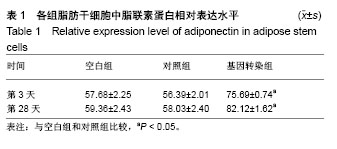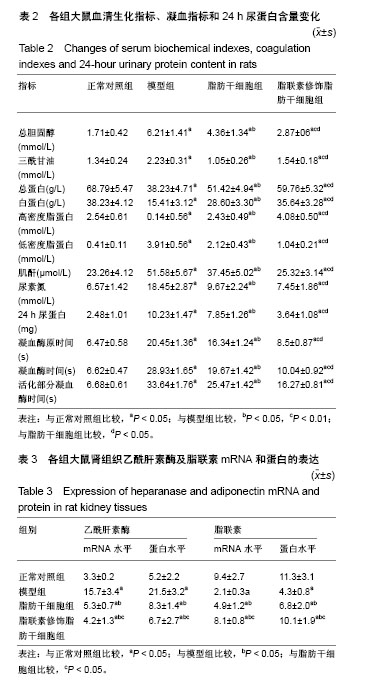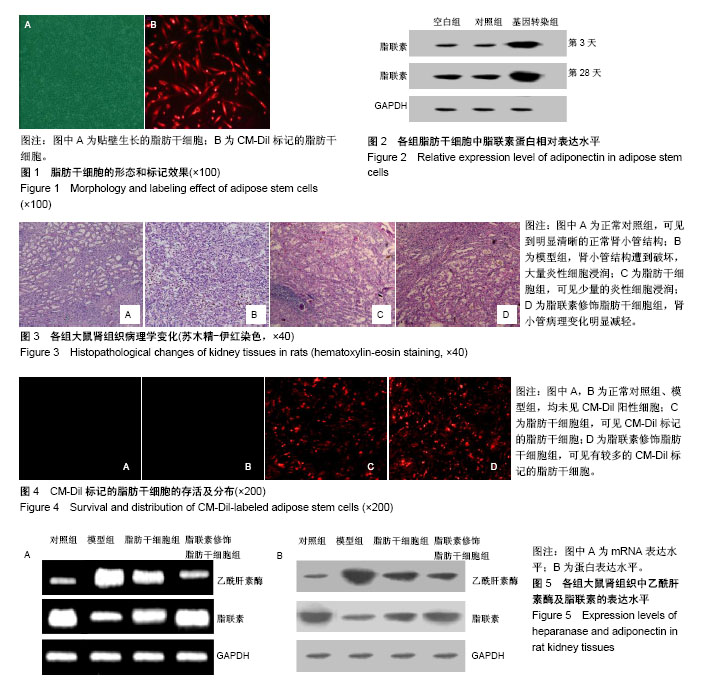中国组织工程研究 ›› 2019, Vol. 23 ›› Issue (5): 723-728.doi: 10.3969/j.issn.2095-4344.1588
• 干细胞移植 stem cell transplantation • 上一篇 下一篇
脂联素基因修饰脂肪干细胞移植治疗大鼠肾病综合征
田 萌1,2,韩鸿玲1
- 1天津医科大学总医院,天津市 300000;2天津市津南区咸水沽医院,天津市 300350
Utilization of adiponectin-modified adipose stem cell transplantation in the rat with nephrotic syndrome
Tian Meng1, 2, Han Hongling1
- 1Tianjin Medical University General Hospital, Tianjin 300000, China; 2Department of Internal Medicine, Xianshuigu Hospital of Jinnan District, Tianjin 300350, China
摘要:
文章快速阅读:
.jpg)
文题释义: 肾病综合征:是人类最常见的肾脏疾病之一,以大量蛋白尿、低蛋白血症、高血脂症为主要特征,常见原因可由原发性肾小球病(如原发性肾小球炎、肾小球局灶性硬化症等)、继发性肾炎(如狼疮性肾病、糖尿病性肾病等)以及继发感染(如细菌、病毒等)、循环系统疾病、药物中毒等引起。目前该病的治疗仍以激素为主,中药为辅。 基因转染:是将具有生物功能的核酸转移或运送到细胞内并使核酸在细胞内维持其生物功能。核酸包括DNA (质粒和线性双链DNA),反义寡核苷酸及RNAi(RNA interference)。基因转染技术已广泛应用于基因组功能研究(基因表达调控、基因功能、信号转导和药物筛选)和基因治疗研究。
摘要
背景:脂联素基因表达在肾病综合征的发病过程中有着重要的作用,移植脂肪干细胞可以对肾病综合征大鼠起到一定的治疗效果。
目的:探讨脂联素基因转染脂肪干细胞移植对肾病综合征大鼠肾功能及凝血功能的改善作用。
方法:①在体外复苏培养脂肪干细胞并制备其细胞悬液,采用CM-Dil进行标记,取第3代脂肪干细胞进行脂联素基因电转染,Western blot检测转染第3天和第28天细胞中脂联素蛋白的相对表达水平;②从80只SD大鼠(北京维通利华动物实验技术有限公司提供)中随机取20只不予任何处理作为正常对照组,其余60只SD大鼠静脉内注射阿霉素建立肾病综合征大鼠模型,随机分为3组:模型组、脂肪干细胞组以及脂联素修饰脂肪干细胞组,正常对照组和模型组大鼠经尾静脉注射20 μL PBS,脂肪干细胞组、脂联素修饰脂肪干细胞组大鼠经尾静脉注射20 μL转染空载质粒的脂肪干细胞悬液或脂联素修饰的脂肪干细胞悬液,1次/d,连续7 d;③移植4周后,全自动生化分析仪检测血清生化指标和凝血指标,苏木精-伊红染色观察肾组织病理变化,RT-PCR、Western blot检测肾组织中乙酰肝素酶及脂联素的表达。
结果与结论:①Western blot检测显示脂肪干细胞中脂联素高表达可持续28 d;②脂联素修饰脂肪干细胞组的病理改善明显优于脂肪干细胞组,脂肪干细胞组较模型组稍有改善;③脂肪干细胞组及脂联素修饰脂肪干细胞组的24 h尿蛋白定量及血清总胆固醇、三酰甘油、低密度脂蛋白、肌酐、尿素氮水平均明显低于模型组(P < 0.05),而血清总蛋白、白蛋白、高密度脂蛋白水平则明显高于模型组(P < 0.05)。脂联素修饰脂肪干细胞组各项生理生化指标均优于脂肪干细胞组,差异有显著性意义(P < 0.05)。脂肪干细胞组、脂联素修饰脂肪干细胞组大鼠的血液高凝状态较模型组明显缓解,脂联素修饰脂肪干细胞组缓解更明显,各组间差异有显著性意义(P < 0.05);④与模型组相比,脂肪干细胞组、脂联素修饰脂肪干细胞组大鼠肾组织中乙酰肝素酶的mRNA和蛋白表达水平明显降低(P < 0.05),而脂联素表达水平明显升高(P < 0.05)。脂联素修饰脂肪干细胞组乙酰肝素酶和脂联素mRNA和蛋白表达水平均优于脂肪干细胞组(P < 0.05);⑤结果表明,脂联素基因修饰的脂肪干细胞移植可以显著改善肾病综合征大鼠的肾功能、血液高凝状态及高脂血症,该作用可能与乙酰肝素酶和脂联素的表达水平有关。
中国组织工程研究杂志出版内容重点:干细胞;骨髓干细胞;造血干细胞;脂肪干细胞;肿瘤干细胞;胚胎干细胞;脐带脐血干细胞;干细胞诱导;干细胞分化;组织工程
ORCID: 0000-0002-4658-5812(田萌)
中图分类号:



.jpg)